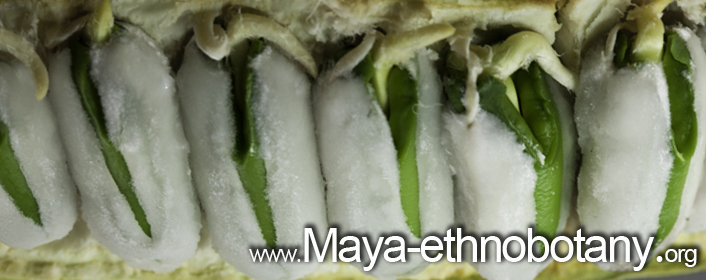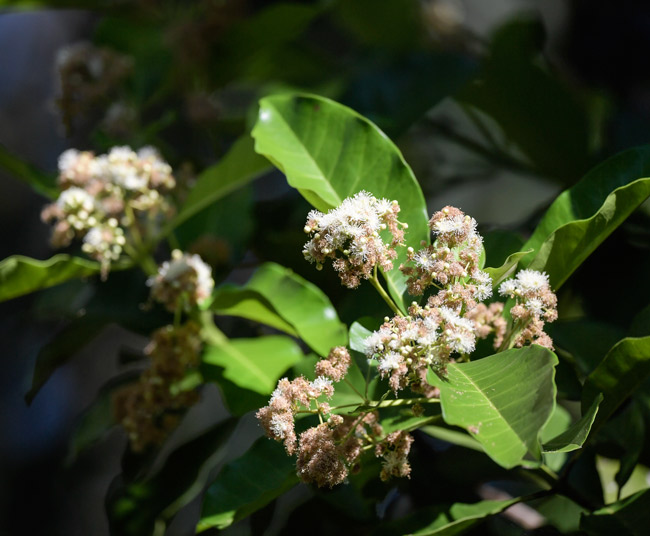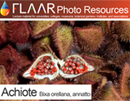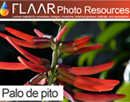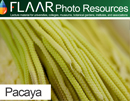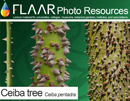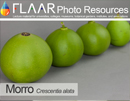When time and funding permit, each flower (each plant species) will have its own page, and its own PDF, and eventually its own PPT so that professors and students have plenty of material on Guatemala (and Honduras, etc) to study.
Heliconia adflexa, Coban, Guatemala, Hotel Monja Blanca, FLAAR, by Nicholas Hellmuth
This space is for flowers
we have recently found and photographed.
|
| Share
|
| Nut is Spice, Mayan flavoring for cacao (cocoa, chocolate), leaves for tea and medicinal |
|
Tropical spices, flavorings, seasoning all in one multi-spice seed Allspice is not a commercial mixture of “all spices.” Allspice is a single tree whose nut-like seed pod has “all flavorings” all together in a single pod: cloves, traditional (back) pepper, cinnamon and nutmeg. All of these are European, Asian or Middle East spices. Allspice is found uniquely in Mesoamerica and elsewhere in Latin America.
In local Spanish it is called pimiento gorda (large pepper (seed), because pepper from the rest of the world is a very small seed. On the Internet it is often called Jamaica pimento though in fact it is native to Guatemala and all surrounding countries. The botanical name is Pimenta dioica. Synonyms are Pimenta officinalis. Pimenta racemosa is a different species. All are of the Myrtaceae, the myrtle family. Parker includes only Pimenta dioica in her book on Trees of Guatemala (2008: 641). She does not include Pimenta racemosa whatsoever because the bay rum tree is from the West Indies (Caribbean islands).
The leaves of pimiento gorda, allspice, are used to make tea When I lived at Yaxha for five annual seasons of work doing the map of the main site (1970-1974) and updating the century-old map of Nakum, we drank allspice tea at least once a week. When I lived 12 months at Tikal, while on a year-off from Harvard as archaeology student intern for the University of Pennsylvania Tikal Project, we drank allspice tea occasionally. Allspice and the leaves are also medicinal This web page is a discussion of the tree as a source of a spice, a flavoring for cacao beverages (cocoa, chocolate); and the leaf is for tea. But especially the leaf has medicinal properties. However I simply drink the tea because it is a nice change from commercially processed tea. When you live in the remote rain forests there is no supermarket nearby, so it helps to have tea from local plants. Where can you find pimiento gorda, allspice, in Guatemala? Tikal National Park and the Yaxha area of the Parque Nacional Yaxha Nakum Naranjo are literally filled with allspice trees. At Tikal they are in the private area behind the smaller museum, to the left of Jaguar Inn hotel. At Yaxha the allspice trees are common, with several of them on the hotel grounds of the Ecolodge El Sombrero (just before the entrance to the park). Then there are allspice trees around the buildings of the park administration, and more around the ruins. In Alta Verapaz you can find them growing on hillsides going into the mountains from Tucuru towards Senahu. This is an all-day drive with 4WD that takes you through awesome mountains. Be sure to have someone with you who knows which road to take at every crossroads: no signs anywhere. You will not see one single solitary tourist other than perhaps at the waterfall to the left of the road (an hour or so after leaving Tucuru). Unless it’s Quetzal bird season, as there is a quetzal preserve another hour up the mountains (turn to the left). Turn to the right to continue on to Senahu: this is the stretch that is almost guaranteed to have no tourists. Once you get to Senahu you can drive to Cahabon (awesome scenery, but very narrow 4WD trail to drive on; often “road” is barely a description). From Senahu to Teleman it’s a modern concrete highway. Then half-paved and half-gravel to El Estor and Rio Dulce (but it’s a highway even when unpaved). There are other places in Guatemala, Belize, Mexico, Honduras and elsewhere to find allspice. Frankly it and palo de jiote are my two absolutely favorite trees due to their peeling bark. Smooth Peeling Bark We will have a separate FLAAR report on the bark of this tree. We will compare it with palo de jiote bark (also peeling but more rust-red). And another “smooth” trunk (after the bark has peeled off) is the guava tree. Guava, Psidium species, is the same Myrtaceae family as Pimenta dioica. What do you need to accomplish good photographs of spice flowers? How to photograph flowers high in a jungle tree: allspice, Pimenta dioica? First it helps to find a tree where the branches are low, so you can photograph with a 100mm or 200mm tele macro lens. Or try to find a tree where you are up on a Mayan pyramid so you can photograph down so you see the flowers from above. Or find a tree in a gully: the idea is you want to be above the branches or at the same level. In the hotel the branches were high and I had to use a 600mm prime telephoto lens. We do have zoom lenses but we try to avoid them because you get more precision with a prime lens. Plus we do not use any after-market telephoto lenses: and never a Tamron or comparable. If you want a good photograph it helps to have a good lens (plus a place filled with dozens of different flowering trees and beautiful birds such as the hotel Ecolodge El Sombrero, Yaxha, Peten, Guatemala). Further reading on allspice We have a team of university students working at FLAAR Mesoamerica doing bibliographies of each plant and animal of the Mayan world. So we will eventualy have a list of suggested reading on allspice. But in the meantime, here is one informative web page: www.herbal-supplement-resource.com/allspice-pimenta-dioica.html
First Posted April 2018 |
Parque Nacional Yaxha, Nakum and Naranjo
Carnivorous Plants
Plants of Municipio de Livingston, Izabal
- Acrostichum danaeifolium, giant leather ferns
- Bellucia Pentamera
- Bibliography on Grias cauliflora
- Bibliography on Licania platypus
- Bibliography on Mangle negro (Avicennia germinans) L.
- Bibliography on Montriacardia arborescens
- Bibliography on Typha domingensis and Thypha latifolia
- Conocarpus erectus, white mangrove
- Edible Wetlands Plants, Hotel Tortugal
- Heliconia latispatha
- Heliconia wagneriana
- Manicaria saccifera Confra palm
- Neotropical trees of Guatemala need protection
- Nymphoides indica, waterlily flowers
- Pachira aquatica, zapoton
- Bibliography on Pithecellobium Mart., Neotropical trees of Mesoamerica
Ecosystems, Wetlands Aquatic Plants
Smartphone Camera Reviews
Bushes and small trees
Fungi and Lichens
Orchids
- Bibliography Bletia purpurea, aquatic orchid
- Bibliography, Epidendrum radicans
- Bibliography on Habenaria Orchids from Yaxha
- Bibliography, Lycaste virginalis var. alba.
- Bibliography, Macroclinium bicolor
- Bibliography, Prosthechea cochleata
- Bibliography Sobralia macrantha, Lirio de San Juan
- Bibliography, Sobralia xantholeuca
- Bibliography on Terrestrial shade orchids from Guatemala
- Bibliography on Terrestrial sunny orchids from Guatemala
Botanical Terms
Maya and Aztec flavorings for cacao, cocoa, chocolate
- Achiote, Bixa orellana
- Bibliography on Achiote, Bixa orellana
- Bibliography on Esquisúchil, Bourreria huanita
- Bourreria huanita
- Cassia grandis, bucut
- Chile Chocolate
- Chile Chocolate (Capsicum annuum var accuminatum)
- Chiranthodendron pentadactylon
- Cymbopetalum penduliflorum
- Guazuma ulmifolia
- Haematoxylum brasiletto
- Piper auritum, hoja santa
- Piper species
- Quararibea funebris
- Sterculia apetala, castaño
- Tagetes sp., Marigold
- Talauma, a variant of Magnolia
- Vanilla orchid
- Virola and nutmeg
Cacao, cocoa, chocolate
Consulting cacao & Theobroma species
Tobacco Ingredients of Aztec & Maya
Trees of Mesoamerica
- Bibliography on Acacia dolichostachya, Wild tamarind
- Bibliography, Bellucia costaricensis
- Bibliography, Bucida buceras
- Bibliography on Coccoloba belizensis Standl.
- Bibliography on Cojoba sp. and Cojoba arborea
- Bibliography, Ficus.
- Bibliography on Haematoxylum campechianum and H. brasiletto
- Bibliography on Hibiscus pernambucensis
- Bibliography on Ipomea murucoides
- Bibliography on Lacmellea standleyi, lechemiel
- Bibliography on Leucaena leucocephala
- Bibliography on mangle rojo (Rhizophora mangle)
- Bibliography on Manzanillo, Alseis yucatanensis Standl.
- Bibliography on Matilisguate, Tabebuia rosea
- Mangrove swamp Trees
- Bibliography on Ruagea insignis
- Bibliography on Pterocarpus officinalis
Bombacaceae, Bombacoideae
Tropical Fruits of the Maya
- Avocado Hass
- Bibliography on Coloc, Talisia floresii
- Bibliography, Dichogamy of avocado species
- Bibliography on Guayo, Talisia olivaeformis
- Bibliography on Laetia thamnia, Bakelac
- Bibliography on Maracuyá, Passiflora quadrangularis L.
- Bibliography on Punica granatum L., Granada
- Cashew
- Cuajilote, Parmentiera aculeata
- Granada
- Guanabas and Annonas
- Guava, Guayaba, Psidium guajava L
- Introduction to Papaya
- Nance a fruit of prehispanic Guatemala
- Passion flowers and fruits
- Passion flower, giant fruit
- Talisia floresii, Sapindaceae
- Carica Papaya Bibliography
Tropical Nuts
Spices, condiments, food coloring
Medicinal Plants
- Aristolochia, The largest flower in Guatemala, Bibliography
- Asclepias curassavica, bibliography
- Bibliography on Ciricote, Cordia dodecandra
- Bibliography on Contrahierba, Dorstenia contrajerva
- Bibliography on Falso hibisco, Malvaviscus arboreus
- Bibliography on Huele de noche, Cestrum nocturnum
- Bibliography on Lirio araña, Hymenocallis littoralis
- Bibliography on Roble Prieto, Ehretia tinifolia
- Bibliography, Tithonia diversifolia
- Canak
- Calliandra general info
- Guava, Guayaba
- Magnolia and Taluma
- Mayan medicinal plants
- Piper
- Tecomasuche, Coclospermum vitifolium
- Bibliography on Sufricay, Malmea depressa
- Bibliography on Wigandia urens
Underutilized edible plants
Edible Plants of the Mayan World
- Acacia, subin, bullhorn acacia
- Bibliography, Annona muricata
- Bibliography, Annona purpurea
- Bibliography, Annona reticulata
- Bibliography on Chipilín, Crotalaria longirostrata
- Bibliography on Chirimoya, Annona squamosa
- Bernoullia flammea
- Canna indica, tamale wrap
- Cuchamper, Gonolobus
- Guava, Guayaba
- Bibliography, Gonobolus sp.
- Bibliography, Parmentiera aculeata
- Pacaya palm Chamaedorea tepejilote
- Split leaf philodendron, Monstera deliciosa
Plants and trees used to produce incense
Utilitarian Plants
- Bibliography, Acacia farnesiana
- Bibliography on Aechmea bromeliifolia
- Bibliography on Agave americana
- Bibliography, native Agave species from Guatemala
- Bibliography on Anthurium crassinervium (Jacq.) Schott
- Bibliography on Balsa, Ochroma pyramidale
- Bibliography on Bamboo, Guadua longifolia (E.Fourn) R.W.Pohl
- Bibliography, Crescentia alata
- Bibliography, Crescentia cujete
- Bibliography on Hule, Castilla elastica
- Blepharidium guatemalense, irayol blanco
- Crescentia alata, Crescentia cujete
- Tecomasuche, Coclospermum vitifolium
- Bibliography on Coxte, Colubrina arborescens
- Bibliography on Madre cacao, Gliricidia sepium
- Bibliography on Tillandsia usneoides
